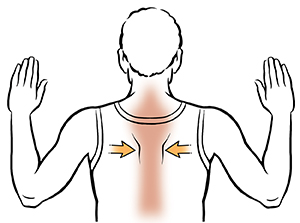The human body is a complex and intricate system, with each component playing a vital role in our day-to-day activities. One such essential structure is the sternum, commonly known as the breastbone. The sternum serves as an anchor point for various muscles and acts as a protective shield for delicate internal organs like the heart and lungs. However, there are instances when the sternum can cause discomfort, pain, or even audible popping sounds. In this article, we will delve into the causes of sternum pain and popping, and explore exercises that can provide relief.
Sternum pain, often accompanied by popping sensations, can be quite alarming and discomforting. The sternum, or breastbone, is a flat bone located in the center of the chest, connecting the ribcage. This essential bone protects vital organs and serves as an anchor for various muscles. While sternum pain can range from mild discomfort to sharp agony, it's crucial to understand its causes and possible remedies. In this blog, we'll delve into the reasons behind sternum pain and popping and explore exercises that may help alleviate the discomfort.
**Causes of Sternum Pain and Popping**
1. **Costochondritis:** This is one of the most common causes of sternum pain. It's an inflammation of the cartilage connecting the ribs to the sternum. Costochondritis can result from injury, overuse, or even respiratory infections.
2. **Sternal Fractures:** A sternum fracture can occur due to traumatic events, such as car accidents or falls. The pain from a sternum fracture can be intense and may require medical attention.
3. **Joint Dysfunction:** The sternum is connected to the clavicle and ribcage through joints. Dysfunction or misalignment in these joints can lead to pain and popping sensations.
4. **Muscle Strain:** Muscular strain or tension in the chest or upper back muscles can radiate to the sternum, causing discomfort.
5. **Tietze Syndrome:** Similar to costochondritis, Tietze syndrome involves inflammation of the costochondral joints, leading to pain and swelling around the sternum.
6. **Popping Sensations:** Popping in the sternum can be caused by the movement of the cartilage or joints. It might not always be a cause for concern, but persistent or painful popping should be evaluated by a medical professional.
**Exercises for Relief**
Before attempting any exercises, it's crucial to consult a medical professional, especially if you're experiencing severe pain or have an underlying medical condition. Here are a few exercises that might help alleviate sternum pain and discomfort:
1. **Deep Breathing:** Gentle deep breathing exercises can help improve lung capacity and reduce tension around the sternum. Inhale deeply through your nose, expanding your chest and allowing your sternum to lift slightly. Exhale slowly through your mouth, relaxing your chest muscles.
2. **Pectoral Stretch:** Stand in a doorway, placing your forearms on each side of the door frame at shoulder height. Gently lean forward, feeling a stretch in your chest muscles. Hold for 15-30 seconds.
3. **Scapular Squeezes:** While sitting or standing, squeeze your shoulder blades together gently, then release. This exercise helps improve posture and reduces strain on the chest muscles.
4. **Cat-Cow Stretch:** Begin on your hands and knees in a tabletop position. Inhale as you arch your back (cow pose), lifting your chest and tailbone. Exhale as you round your back (cat pose), drawing your sternum towards your spine.
5. **Wall Angels:** Stand with your back against a wall and your arms bent at 90 degrees, resembling a "W" shape. Slowly slide your arms up the wall, maintaining contact, and then lower them back down.
6. **Shoulder Blade Squeeze and Release:** Sit or stand comfortably. Squeeze your shoulder blades together as if trying to hold a pencil between them. Hold for a few seconds, then release. Repeat several times.
**Conclusion**
Sternum pain and popping sensations can vary in intensity and cause, but they are often manageable with proper care. If you experience persistent or severe pain, it's recommended to consult a healthcare professional for an accurate diagnosis and personalized treatment plan. In many cases, a combination of exercises, gentle stretches, and medical guidance can contribute to alleviating discomfort and promoting overall chest health. Remember, each individual's condition is unique, so tailor your approach according to your specific needs and always prioritize your well-being.
**DISCLAIMER** - This blog is only for educational purposes, All the content is found on the internet, and we advise you to take precautions while exercising. We are not responsible for any harm caused while doing the same.










0 Comments